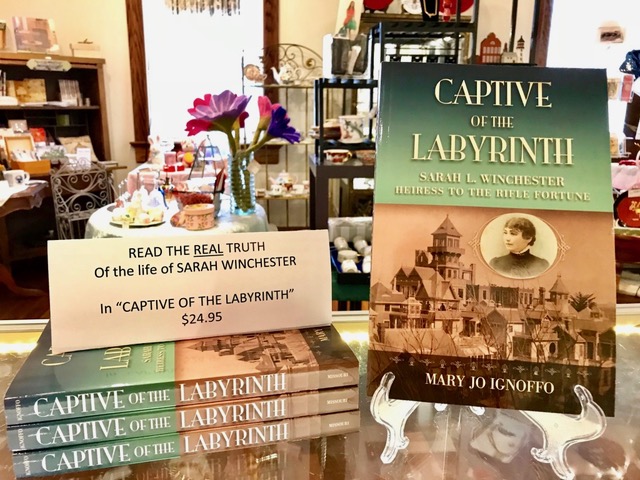by Linda Kubitz
Superstitious and crazy! Haunted by ghosts! Obsessed by numerology! These are a few of the wide-spread rumors and mysteries which surrounded Sarah Winchester when she lived in the Bay Area a century ago and are still being fostered today. The recent release of the movie “Winchester”, a sensationalized film-portrayal of the life of Sarah Winchester, prompted our museum store manager, Margaret Lawson, to order several copies of Captive of the Labyrinth. Written by historian and De Anza College history instructor Mary Jo Ignoffo, Captive of the Labyrinth explains away the superstition and the myths long associated with Mrs. Winchester. To discover the real Sarah Winchester, stop by the museum store and pick up a copy of the book. In addition to the story of Sarah’s life, the book gives a fascinating history of the Winchester rifle and a nostalgic look back at the history of the Santa Clara Valley and the Peninsula in the late 1800s and early 1900s.
Following are a few myths about Sarah’s life and some facts from Captive of the Labyrinth, which set the record straight.
Myth: The constant building of Sarah’s grand home would keep death away from her door.
Fact: A local newspaper created that myth. Sarah actually enjoyed the process of construction and design, and taking an active role in the creation of her palatial home was a type of tonic for her emotional and physical health.
Myth: Sarah was thought to be a crazy lady who would not mix with the local community.
Fact: Sarah preferred a quiet, peaceful life without intrusion from the outside world. She was close to her sisters and nieces, and kind to the servants, ranch workers and their families who worked for her, but wanted nothing to do with the community outside her gates. In later years Sarah suffered from severe rheumatoid arthritis which left her face disfigured and her body stooped, two more reasons she preferred to keep to herself.
Myth: Sarah’s mansion was constructed with stairs that led nowhere and doors which opened onto walls.
Fact: Much of the home was destroyed in the 1906 earthquake, and rather than face the task of rebuilding its towers, turrets, and upper stories, Sarah simply had parts of the house boarded up. Stairs, for example, led to a wall because the room that had once been on the other side, had fallen away during the quake.
Fact: Upon her death Sarah’s San José mansion was sold to an amusement company in Ohio with the express purpose of turning her so-called “mystery” home into a tourist attraction.
Fact: The new owner perpetuated and embellished the myths that surrounded the mansion, adding even more “stories” in order to enhance his investment in his tourist site.
For the true story of Sarah Winchester’s life read Captive of the Labyrinth. I found Ms. Ignoffo’s diligent research of Sarah’s actual life to be so compelling, I am saddened that the producers of the movie “Winchester” chose to depict Sarah’s life to be a convoluted horror story. With a script like that, the myths surrounding Sarah and her home will, I fear, prevail.


